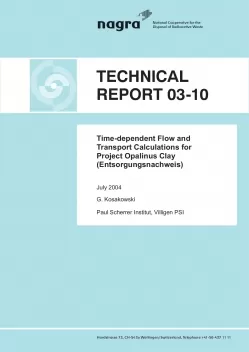
Technical Report NTB 03-10
Time-dependent Flow and Transport Calculations for Project Opalinus Clay (Entsorgungsnachweis)
This report describes two specific assessment cases used in the safety assessment for a proposed deep geological repository for spent fuel, high level waste and long-lived intermediate-level waste, sited in the Opalinus Clay of the Zürcher Weinland in northern Switzerland (Project Entsorgungsnachweis, NAGRA, 2002d).
In this study the influence of time dependent flow processes on the radionuclide transport in the geosphere is investigated. In the Opalinus Clay diffusion dominates the transport of radionuclides, but processes exist that can locally increase the importance of the advective transport for some time. Two important cases were investigated:
(1) glaciation-induced flow due to an additional overburden in the form of an ice shield of up to 400 m thickness and (2) fluid flow driven by tunnel convergence.
For the calculations the code FRAC3DVS (Therrien & Sudicky, 1996) was used. FRAC3DVS solves the three-dimensional flow and transport equation in porous and fractured media.
For the case of glaciation-induced flow (1) a two-dimensional reference model without glaciations was calculated. During the glaciations the geosphere release-rates are up to a factor of about 1.7 higher compared to the reference model. The influence of glaciations on the transport of cations or neutral species is less than for anions, since the importance of the advective transport for anions is higher due to the lower accessible porosity for anions. The increase in the release rates during glaciations is lower for sorbing compared to non-sorbing radionuclides. The influence of the tunnel convergence (2) on the transport of radionuclides in the geosphere is very small. Due to the higher source term the geosphere release rates are slightly higher if tunnel convergence is considered.
In addition to the two assessment cases this report investigates the applicability of the one-dimensional approximation for modelling transport through the Opalinus Clay. For the reference case of the safety assessment the model chain STMAN-PICNIC-TAME is used. In order to evaluate radionuclide release and transport, the geometry of the repository near-field/geosphere system is simplified and the Opalinus Clay is treated as a one-dimensional layer. In this study the code FRAC3DVS is used to assess the effects of the simplifications by calculating a two-dimensional model which includes both the Opalinus Clay and the SF / HLW bentonite annulus.
The one-dimensional approximation gives results similar to the geometrically more realistic FRAC3DVS model. Discrepancies introduced by the one-dimensional approximation are shown to be small and the results are always conservative compared with the FRAC3DVS calculations. This modelling exercise thus gives strong support for the applicability of the one-dimensional approximation.
